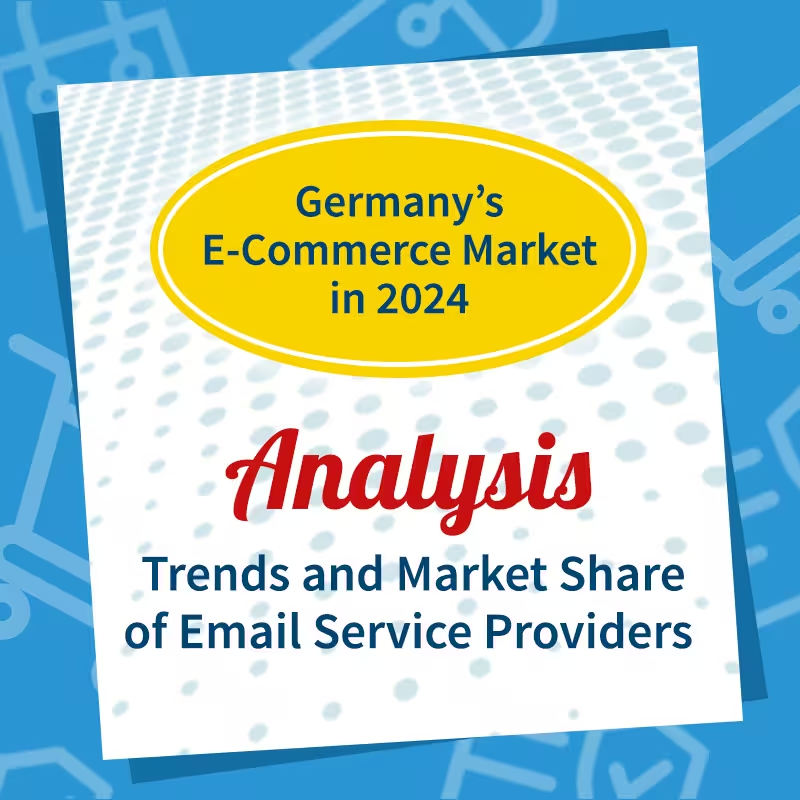Risk or opportunity? Use your primary domain for marketing emails
All companies that send email marketing campaigns in addition to business email correspondence are faced with an important question when configuring the delivery settings of their email delivery tool: “Should all emails from my company be sent via the same domain? After all, customers know my domain "@firma .de” — using this sender for newsletters or promotions certainly means a huge leap of faith? ”
This assumption is not wrong: The positive reputation of the business email domain may have a positive effect on promotional emails — both on a technical and personal level. However, care should be taken when it comes to the technical level of email deliverability. A worsening of reputation due to the sending of promotional emails can also have a negative impact on business emails. In addition, there are technical challenges that require a more differentiated view of the topic.

One domain for everyone: Delivery via the main domain
When using your main domain (company.de) for business and marketing emails, there is a risk of a shared reputation. Internet service providers (ISPs) and spam filters calculate a reputation for each sending domain. This is based on differently weighted factors, including:
- Engagement rate
- Spam complaint rate
- Spam trap hits
- Bounce rates
- List unsubscribe rate
The worse the reputation of a sending domain, the greater the risk that ISPs or spam filters block emails from that domain or move them to the spam folder. Even important business emails can be affected.
However, if you don't send generic mass emails to thousands of contacts, but targeted promotions with relevant content to selected and well-maintained target groups with high engagement rates and few complaints and cancellations, the risk of negative influences is lower.
So is the answer: Anyone who sends little can also use the main domain as a shipping domain in the newsletter tool? Yes!
The challenge with authentication
If you use different shipping systems for a domain, the required technical settings (SPF, DKIM) must be set correctly for each of these systems.
DKIM and SPF themselves aren't difficult to configure. The bigger challenge is that the DMARC entry must be set for both systems and the DKIM and SPF alignment must match for both systems.
With SPF alignment, there must be a match between the header domains in the return path and the “header from”. With DKIM alignment, the domain from the DKIM signature must match the “header-from” domains. This must be checked and adjusted for your own business emails and for external systems that use the same domain.
There are of course still differences between relaxed and strict alignment — You can find out more at Certifed-Senders.org.
Many companies prefer not to use their main domain — if only because of the necessary adjustment of the DNS entries — to send advertising emails from the email delivery tool. Instead, they use a dedicated subdomain, for which all settings can be configured separately.
Authentication and domain alignment are mandatory
It is less and less advisable to refrain from implementing authentication methods or to approach the alignment only half-heartedly. They are now mandatory criteria for numerous mailbox providers for the delivery of emails:
- Gmail and Yahoo: Since February 2024, SPF, DKIM and DMARC authentication has been mandatory for mass senders (> 5,000 emails/day)
- Outlook: Since May 2025, senders have had an SPF, DKIM and DMARC requirement. Non-compliant emails are completely blocked. Although the rule only applies to mass senders (> 5,000 emails/day) for now, your reputation also suffers if you don't follow the rules
How many domains do you need?
Using your own subdomains to send marketing emails is a good way to avoid unwanted effects if the reputation of the main domain is shared. In this way, authentication and domain alignment can be set up specifically for the individual systems.
It is also recommended that you also use your own subdomain to send transaction emails — such as order confirmations from the shop or notifications from the customer portal. Transactional emails are business-critical because they are not promotional, can be sent without an advertising opt-in and should therefore not be sent via the same (sub) domain as advertising emails. Because every subdomain goes through its own spam filter process and has its own reputation. In the event of a possible loss of reputation in marketing, other e-mail traffic remains unaffected.
Some experts recommend using separate (sub) domains for each mailing type. However, make sure that the above-mentioned DKIM and SPF alignment must also be coordinated for each subdomain in the email sending tool and in the subdomain's DNS settings: the return path domain and the sender domain must match! However, many email marketing delivery tools don't even offer the option of managing multiple return-path domains per account. In order to achieve strict alignment, you would therefore have to set up a separate account for each mailing type. This would have a major impact on marketing processes and tool licenses. Therefore, seek advice on what can and cannot be implemented in your marketing automation tool.
Let's get back to our initial question: “Can I use my primary domain in my marketing emails?” The answer is still: “Yes!”
For promotional emails that are sent via a newsletter delivery tool, we recommend using subdomains — as well as for sending transactional emails. However, there are certainly use cases where it makes sense to use the main domain for marketing automation — provided that you overcome the challenges of authentication and domain alignment!
Sending automation on behalf of employees
One of these exceptional use cases is automated (sales) emails such as cross-selling and upselling emails to customers whose sender (name + email address) should be the personal advisor or account manager. Responses to the emails should therefore also end up directly in the account manager's mailbox and not at a collective address.
Such mailing formats are very successful in B2B. In these cases, you can definitely configure the marketing automation tools so that these simulated 1:1 mailings are sent from the consultants' main domain addresses.
If this is not possible in terms of configuration in your shipping tool, a subdomain can also be used in the marketing tool for these cases. To do this, create a similar address for each consultant (max.muster@mail.firma.de instead of max.muster@firma.de). Reply management must then ensure that the answers are forwarded to the right place.
Conclusion: The right domain strategy is individual.
There is no general answer to the decision between main domain and subdomain for your email marketing. It depends on various factors: the volume of shipments, the nature of your campaigns, your technical capabilities, and your willingness to take risks.
For most companies, a subdomain strategy is recommended because it minimizes risks and offers clear benefits.
- Protecting the main domain reputation
- Easier authentication and domain alignment
- Separate control over different types of email
Setting up the main domain in the marketing automation tool can be useful if you:
- conduct highly targeted, personalized email marketing with low shipping volumes
- use simulated 1:1 communication in the B2B sector.
- be able to overcome the technical challenges of authenticating a domain in multiple systems
- and if your email delivery tool allows you to use the primary domain.
Regardless of your decision, the correct implementation of authentication methods (SPF, DKIM, DMARC) is becoming increasingly important in light of the tightening requirements of major email providers.
Addendum: The difference between delivery rate and inbox placement
Please don't confuse the “Delivery Rate” with the “Inbox Placement Rate.” A high delivery rate means that your shipping lists are well maintained and that only a few hard bounces are generated. In most email sending tools, however, you can only see that the emails have been delivered technically, but not whether they end up in the spam filter.
A decline in reputation and an increased spam score can result in your emails ending up in the spam folder or, in the worst case, being rejected. If you want to know where your emails end up and what factors influence your spam score, use deliverability services such as Publicare Email Delivery Guide.















